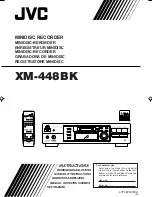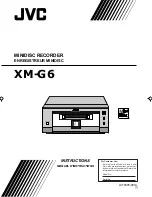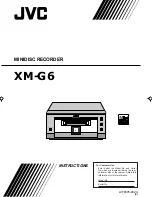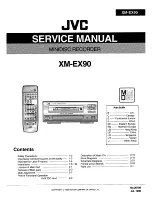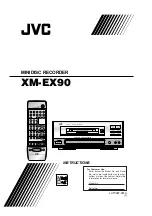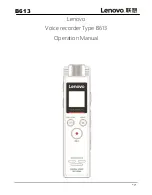
©1999 Hamtronics, Inc.; Hilton NY; USA. All rights reserved. Hamtronics is a registered trademark. Revised: 1/28/00
- Page 8 -
Remote Control Circuits.
In order for the COR-5 Control
Board to control the record and
playback cycles of the DVR-3, two
control lines are connected to the
COR board. These simulate the ac-
tions of the manual switches, S1
and S2.
Playback control is connected
through the brown wire to a dedi-
cated port on the microcontroller
chip on the COR-5. When the con-
troller decides playback is required,
it applies a ground pulse of approxi-
mately 100 milliseconds duration to
the Playback Control input on the
DVR-3. This starts the playback cy-
cle, which continues due to the
latching action of Q1, R4, and R5, as
previously described. At the end of
the message, U1 EOM pin 25 un-
latches Q1.
To record, the controller board
grounds the Playback Control line
continuously while also grounding
the Record Control line coming into
Q4. Switches Q4 and Q5 have the
same effect as pressing RECORD
switch S2, i.e., putting U1 in the re-
cord mode.
The Record Control line is con-
nected to the circuit on the COR-5
board which operates the Time Out
led. Since no more microprocessor
ports were available, the port which
operates the led also is used for Re-
cord Control.
Q2/Q3 ID Key Circuit.
The base of Q2 is biased on or off
by current from R1 in the Q1 latch
circuit. When that circuit is in a
playback cycle, Q2 is turned on,
which applies bias to turn on Q3.
That transistor, in turn, applies a
ground to the exciter keying circuit
on the COR-5 board. This action
holds the transmitter on while an
ID message is played back and ope r-
ates independently from the micro-
controller on the COR-5 board which
normally keys the transmitter.
Addressing.
There are two types of addresses
used in the U1 chip. The first is an
internal address pointer, which at
any given time, keeps track of which
memory cell is next to be read or
written. At the beginning of a rec-
ord or playback cycle, it starts at a
starting location and cycles through
until the end of the message and
remains there until the PD line is
brought high, which resets it to the
starting address again.
The starting address normally is
set by the address control lines on
the upper left side of the pc board.
As the board comes from the factory,
these lines are all strapped to
ground by pc board traces; so the
starting address is zero. If one or
more of these lines is raised to
+5Vdc, the starting address for a
given record or playback cycle is
changed to some other location in
memory. There is an extensive dis-
cussion of memory addresses ear-
lier in this manual, under
OPERATION,
in a subsection titled
Addressing More Than One Message.
Power Distribution.
In the DVR-3, the +5Vdc operat-
ing voltage for the board is derived
from the reg5Vdc power bus
on the COR-5 board. Electrolytic
capacitor C13 provides a low ac im-
pedance for the 5V bus on the DVR-
3 board.
There are two se5Vdc
busses on the DVR-3 board and
separate sets of Vcc and Vss pins on
the recorder ic for digital and analog
power supplies. Because noise from
the switching and clock circuits in
the chip could affect the quality of
the recording and playback audio,
these two power paths are carefully
separated and filtered from each
other at various frequencies from
audio up through the vhf range.
This is also the reason a special mi-
crophone reference line is used to
carefully establish the reference
point used for the op-amp micro-
phone preamp to suppress any noise
from affecting the recording. It is
important to maintain these fea-
tures if you make any modifications
to the circuits.
TROUBLESHOOTING.
General.
Tracking down trouble is fairly
straightforward. The
Theory of Op-
eration
section describes the signal
path and what each circuit does.
Remember that the ic's are
static sensitive. You don't want to
further damage the board while
troubleshooting. A ground wrist
strap should be worn when handling
the ic's.
Significant logic voltages are
high's (near +5V) and low's (near
ground) as marked on the schematic
by the little pulse symbols. Follow-
ing is a stage-by-stage description of
other voltages which should be pr e-
sent under various conditions.
A logical troubleshooting proce-
dure would be to start by checking
for expected operation with the
manual playback and record
switches, S1 and S2. If you can't
hear any audio or the transmitter
does not key when S1 is pressed
momentarily, then check various
voltages and logic levels. An os-
cilloscope may be necessary to
check audio levels. If the unit
works manually but the timer and
external trip circuits do not respond
as expected, then trace those sig-
nals through the circuit, referring to
the schematic diagram and in-
formation in the
Theory of Operation
section of the manual.
Digital Recorder U1.
All analog circuits in 1020A ic U1
are referenced to an internally gen-
erated bias of approximately 1.5Vdc.
This voltage can be measured at the
mic input (pin 17), mic ref (pin 18),
ana input (pin 20), and ana output
(pin 21), but only in the record
mode. In playback mode, these pins
measure near ground. The audio
output pins (14 and 15) should each
measure about 1.5 Vdc to ground in
playback mode.
The agc line at U1 pin 19 rests at
about 1.5Vdc in record and peaks up
just a little bit if you apply loud
audio to the audio input to make the
agc take action.
Here are some typical ac voltage
measurements. In record mode, the
mic input voltage at pin 17 should be
about 20 mVp-p. The analog input
voltage at pin 20 should be about 50
mVp-p. In playback mode, the audio
output between pins 14 and 15
should be about 3Vp-p (1.5Vp-p ref
ground).
The control signal pins on U1 are
at logic levels noted on the sche-
matic. The only one which isn't ob-
vious is the EOM line at pin 25,
















